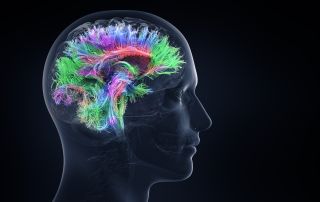Attention
Fame in the Brain—Global Workspace Theories of Consciousness
GWT is a strong but incomplete theory of consciousness.
Updated October 28, 2023 Reviewed by Michelle Quirk
Key points
- GWT proposes that information in the brain becomes conscious when broadcast across a "global workspace."
- Global neuronal workspace theory (GNWT) extends GWT, defining more specific neuronal regions and mechanisms.
- GNWT helps explain "conscious access," and how consciousness is related to attention and working memory.

This is part 3 of a five-part series. Part 1 provided an overview of the leading theories of consciousness. In this post, we will focus on global workspace theories (GWTs). These theories propose that information in the brain becomes conscious when it gains access to a "workspace" and is broadcast to the rest of the brain. The term "global workspace" comes from artificial intelligence.1
The Attentional Spotlight
The analogy is often made to a "spotlight"—as if the mind were a theater where conscious thought is the activity in the spotlight on the stage at a given moment. Since the spotlight is narrow, only a limited number of thoughts or perceptions can be illuminated by it at a given time (only a fraction of the vast amount of information processed in the brain can be conscious at any moment). Many other thoughts or perceptions stay in the background, ready to enter the spotlight at a moment’s notice if needed, determined by the level of importance of the information.
For example, if the brain is focused on one activity—say reading—and suddenly there is a loud noise, the perception and interpretation of the unexpected noise will immediately take the spotlight. Information competes for the attentional spotlight, determined by its salience and relative importance according to goals, needs, and context. A lot of the brain’s important activities take place "backstage," never to enter the spotlight, but nevertheless crucial for keeping the show running (for example, regulating the body’s autonomic and metabolic functions).
One caveat: Unlike in the theater stage analogy, the actual workspace in the brain is not localized but rather is distributed across wide regions of the cortex.
The original global workspace theory was developed in the late 1980s by cognitive scientists Bernard Baars and Stan Franklin and later expanded upon by various researchers.
Global Neuronal Workspace Theory—A More Specific Version of GWT
Stanislas Dehaene and Jean-Pierre Changeux extended global workspace theory by developing experimentally testable models and identifying more specific brain regions that might play a key role in the global workspace. This form of the theory, known as global neuronal workspace theory (GNWT), is defined by several key ideas:
- According to GNWT, the brain consists of specialized, modular regions that process different types of information. A distributed network of neurons connects these regions and is capable of disseminating or "broadcasting" information across a "global workspace," achieving conscious access. Fronto-parietal (as well as anterior temporal and other) networks are thought to play a central hub-like role in the network that forms the workspace, orchestrating the broadcasting of information and facilitating conscious access.2
- Conscious perception and cognition occur when information is broadcast to the whole workspace. The philosopher Daniel Dennett has referred to this as “fame in the brain.” The information that is broadcast becomes broadly accessible to different cognitive processes, allowing it to influence a wide array of mental functions.
- The broadcasted signal is amplified, prolonged, and shared with the other specialized modules through a process referred to as "ignition." Ignition is thought to be associated with a specific pattern of brain activity that might be measurable using specialized brain imaging and electrophysiology techniques.
- GNWT emphasizes the role of long-range loops between cortical areas (and probably also subcortical regions), which are linked with feedforward and feedback connections.3 Thus, loops of information flow back and forth between these areas. This recurrent (or re-entrant/reverberant) processing enables ignition, amplifying and sustaining the signal as it is broadcast across the network. Information gets integrated and elaborated.4
- Since conscious awareness is a limited resource, the attentional "spotlight" selects and prioritizes information for conscious access.
- Information can be processed locally by the specialized, modular regions without being broadcast to the global workspace, in which case it remains non-conscious. Non-conscious information processing performs vital roles in the background, as noted earlier—not just autonomic functions but also influencing various aspects of behavior and decision-making outside of our awareness.
Evidence and Challenges for GWT/GNWT
As summarized by Seth and Bayne in their 2022 paper,5 there is empirical support for GWTs from studies that have associated consciousness with neuronal signatures of ignition and long-distance information sharing. On the other hand, GWTs, as with higher-order theories of consciousness (HOTs), are challenged by evidence that anterior regions might mainly be involved in behavioral report rather than consciousness per se (i.e., the brain’s higher regions may mainly be involved in access to, control of, and "reporting" of conscious experience once that experience has already been generated, rather than the actual underlying process of generating the experience).
There is also ongoing debate about the relative role of prefrontal versus posterior regions of the cortex in conscious events. But Baars and colleagues argue in a 2021 paper that this is a false dichotomy: “This dichotomy is not obvious, given the interactivity of the cerebral cortex as a whole. It is far more likely that many different cerebral regions interact with each other from moment to moment, and that a static ‘front vs. rear’ contest is simply misleading."6
GWT differs from the HOT approach in the emphasis GWT puts on ignition and broadcast vs. HOT's emphasis on metarepresentation.7,8
Seth and Bayne point out that, like HOTs, GWTs focus on the question of what makes a representation conscious, rather than what accounts for the qualitatively distinct feelings of the different subjective conscious experiences. This is a general tendency of such theories—to focus on functional, rather than phenomenal, aspects of consciousness. It's probably a more practical approach at this relatively early stage in the study of the mechanisms of consciousness. GWTs are essentially focused on the mechanism of "conscious access"—"why certain representations are available to be flexibly used by a wide range of consuming systems (whereas others aren’t)” and “the ability of conscious states to guide behaviour and cognition in flexible, context-dependent ways."9
A strength of GWTs is the clear account they propose for how consciousness is related to other centrally important cognitive processes, such as attention and working memory. Simply put, “Attention and working memory reflect ‘what is on the mind.’" Mashour and colleagues note that “GNW models share many features with models for attention and working memory, which also require interactions between neurons in widespread networks.” But they caution that the relationship between attention, working memory, and conscious awareness is complex.10,11
GWT is compatible to some degree with various other theories of consciousness.12
While lacking an explicitly evolutionary focus, GWT is compatible with theories of consciousness that are grounded in evolution and that add the crucial dimension of learning as a key to the evolution of consciousness.13
Attention schema theory, another compelling theory of consciousness, builds on GWT.14
Important details of GWT still need to be worked out. In particular, what exactly is required for a workspace to qualify as "global"?15
A Collaborative Adversarial Study Pitting GNWT Against Integrated Information Theory
GNWT makes some testable predictions, as do some rival theories of consciousness. In recent years there has been a concerted effort to test some of those predictions head-to-head. One scientifically rigorous way to do so is to get the proponents of the rival theories to agree in advance on a few specific predictions of their respective theories and to jointly design a study that might confirm or disconfirm those predictions. A project organized by a consortium called COGITATE has been attempting to do just that, testing predictions made by Stanislas Dehaene for GNWT against those of Giulio Tononi for his integrated information theory (IIT).
The results for the first phase of that study16 were announced at a large public event during the annual meeting of the Association for the Scientific Study of Consciousness in New York City in June 2023. Study participants had undergone measures of brain activity while engaging in active and passive visual perception. The results were surprisingly mixed.17 Both theories scored and lost points. Among other things, Dehaene had predicted there would be greater activity in the front of the brain, while Tononi predicted the activity would be mainly in the back of the brain. Some of Tononi’s predictions seemed to fare a little better, but critics have argued that the design of the study did not address the core claims of IIT, and Dehaene expressed confidence that a second ongoing experiment by COGITATE will favor GNWT.
Controversy When the Media Interpreted a Win for IIT Over GWT and Other Theories
IIT has for several years been attracting a disproportionate amount of media attention and admiration, and the results of the COGITATE study brought even more attention to it, with media articles implying that IIT is now the dominant theory of consciousness. This has apparently been greatly annoying to many consciousness scientists, who do not share that view. A storm of controversy erupted in September 2023 when a large number of prominent consciousness scientists (not including Dehaene18) signed a letter calling IIT “pseudoscience” and expressing concern that the media are misleading the public in suggesting that IIT is the leading theory of consciousness.
We'll be looking at the intriguing theory of IIT next in this series, trying to understand why many scientists seem unimpressed by its radical implications while the media seem to find these so appealing.
References
1. In AI research, global workspace refers to a fleeting memory domain that allows for cooperative problem-solving by large collections of specialized programs [Baars, B. J., Geld, N., & Kozma, R. (2021). Global Workspace Theory (GWT) and Prefrontal Cortex: Recent Developments. Frontiers in Psychology, 12, 749868. https://doi.org/10.3389/fpsyg.2021.749868]
2. As explained in a 2020 review by the originators of GNWT, “The prefrontal cortex (PFC) is posited to play a key role in the GNW because of the greater density of neurons thought to be critical for global broadcasting of information, but it is not proposed as the exclusive territory for conscious access.” [Mashour, G. A., Roelfsema, P., Changeux, J. P., & Dehaene, S. (2020). Conscious Processing and the Global Neuronal Workspace Hypothesis. Neuron, 105(5), 776–798. https://doi.org/10.1016/j.neuron.2020.01.026]
3. Mashour, et al (2020).
4. The role of recurrent/re-entrant processing is a point of agreement among the different theories of consciousness that are the subject of this five-part blog series. All the main theories suggest that some mechanism of neural feedback or recurrent processing is needed for consciousness: from a higher-order area (in some versions of HOT), from the global workspace (in GNWT), within the posterior hot zone (in IIT), or locally within sensory areas (in RPT). [Yaron, I., Melloni, L., Pitts, M. et al. The ConTraSt database for analysing and comparing empirical studies of consciousness theories. Nat Hum Behav 6, 593–604 (2022). https://doi.org/10.1038/s41562-021-01284-5]
5. Seth, A. K., & Bayne, T. (2022). Theories of consciousness. Nature reviews. Neuroscience, 23(7), 439–452. https://doi.org/10.1038/s41583-022-00587-4.
6. Baars, B. J., Geld, N., & Kozma, R. (2021). Global Workspace Theory (GWT) and Prefrontal Cortex: Recent Developments. Frontiers in Psychology, 12, 749868. https://doi.org/10.3389/fpsyg.2021.749868.
7. Seth, A. K., & Bayne, T. (2022).
8. Mashour et al. elaborate that HOT theories are similar to GNWT in that they generally posit a central role for the prefrontal cortex (PFC) in consciousness. However, for HOTs, that role is to generate a second-order, metacognitive representation of a first-order state (e.g., of one generated by primary sensory cortex). For HOTs, the meta-representation is the mechanism by which a first-order representation becomes conscious. The PFC is therefore the ultimate source of consciousness, according to HOTs. So, the two theories propose very different functions for the PFC. Also, according to GNWT, global broadcasting is an important function associated with consciousness, whereas, according to HOTs consciousness has no clear function. [Mashour, G. A., Roelfsema, P., Changeux, J. P., & Dehaene, S. (2020)]
9. Seth, A. K., & Bayne, T. (2022).
10. Mashour, et al. (2020).
11. Seth and Bayne explain that “attention selects and amplifies specific signals, allowing them to enter the workspace (and thus be conscious); while consciousness and working memory are intimately related because attended working memory items are conscious and use the global workspace for broadcast.” [Seth, A. K., & Bayne, T. (2022)]
12. Baars, B. J., Geld, N., & Kozma, R. (2021).
13. Zacks, O., & Jablonka, E. (2023). The evolutionary origins of the Global Neuronal Workspace in vertebrates. Neuroscience of Consciousness, 2023(2), niad020. https://doi.org/10.1093/nc/niad020
14. Attention schema theory adds the extra component of a system in the brain that can model itself, monitor what it's doing, and build a self-description.
15. Seth and Bayne ask if the "global" character of the workspace is determined by the number (and type) of consuming systems to which the workspace can broadcast, or whether what matters more is the kind of broadcasting that occurs within the workspace. Or both. “These questions need to be answered if we are to know what predictions GWTs make with respect to consciousness in, for example, infants, individuals with brain damage, split-brain patients, non-human animals and artificial intelligence systems.” [Seth, A. K., & Bayne, T. (2022)].
16. Melloni L, Mudrik L, Pitts M, et al. An adversarial collaboration protocol for testing contrasting predictions of global neuronal workspace and integrated information theory. PLoS One. 2023;18(2):e0268577. Published 2023 Feb 10. doi:10.1371/journal.pone.0268577.
17. Cogitate Consortium, "An adversarial collaboration to critically evaluate theories of consciousness," bioRxiv (2023) (preprint) https://doi.org/10.1101/2023.06.23.546249: “These results confirm some predictions of IIT and GNWT, while substantially challenging both theories: for IIT, a lack of sustained synchronization within posterior cortex contradicts the claim that network connectivity specifies consciousness. GNWT is challenged by the general lack of ignition at stimulus offset and limited representation of certain conscious dimensions in prefrontal cortex.”
18. Dehaene did express criticism of IIT on X (formerly Twitter): “While not a big fan of the recent ‘pseudoscience’ name-calling, I have to confess that, like my 124 colleagues, I am quite disappointed by IIT's inability to make anything but banal predictions concerning the recent ARC-Cogitate adversarial collaboration.”




